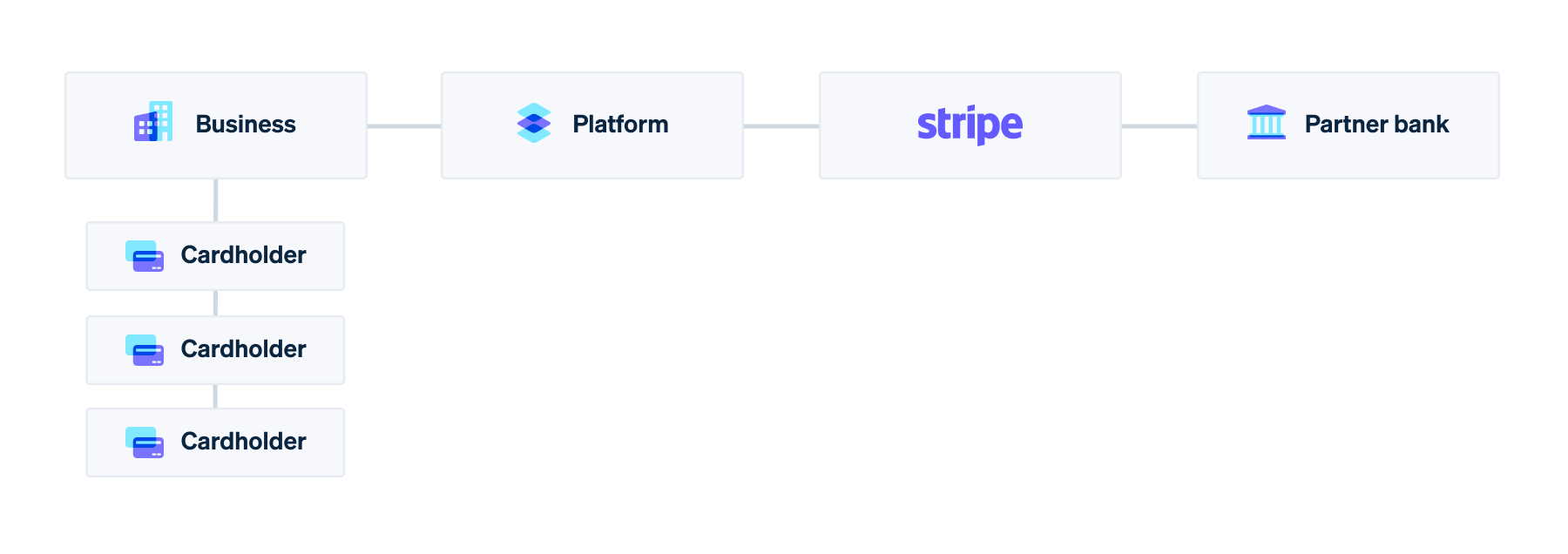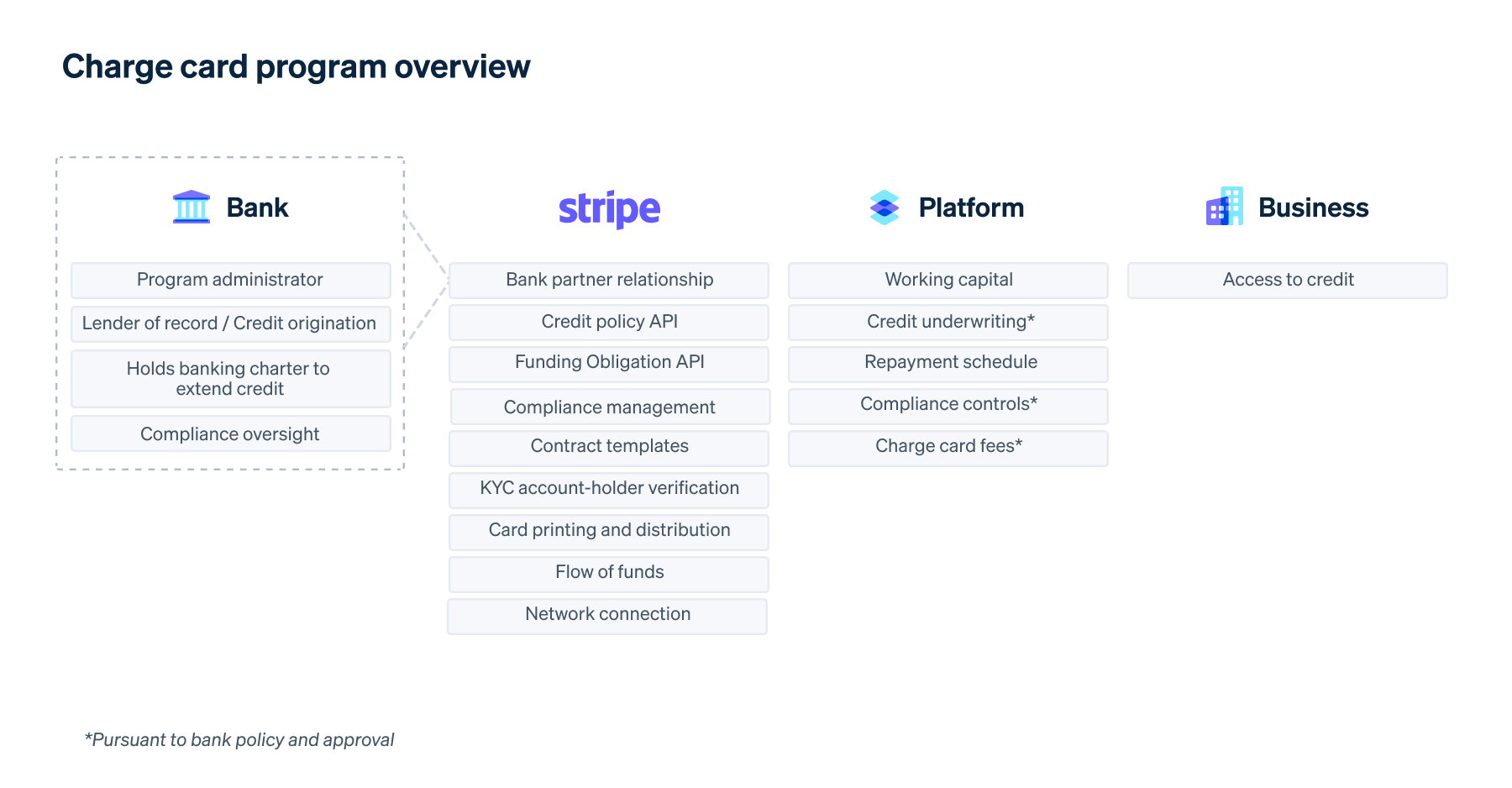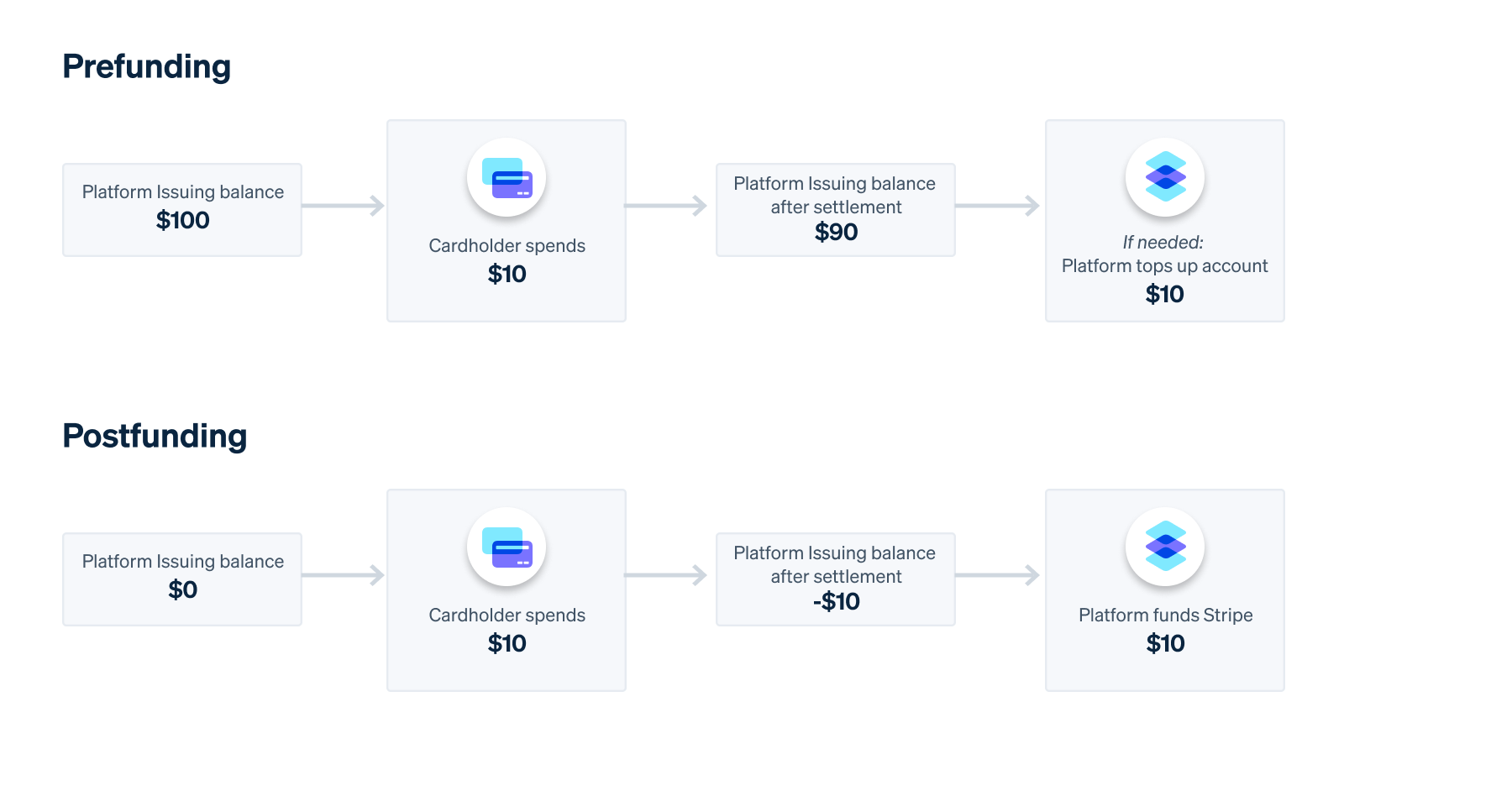无论平台是希望提高产品的用户粘性,还是有意开拓新的收入来源,提供签账卡服务都可能成为其业务中极具吸引力的一部分。通过签账卡方案,账户持有人可先消费、后向平台还款。
虽然签账卡在理论上优势明显,但打造相关方案却颇具挑战。平台需要考虑如何为银行卡提供资金、如何收回还款、如何处理贷款合规事宜等。幸运的是,Stripe 等银行即服务 (BaaS) 提供商能够提供相关支持。
从整体来看,BaaS 提供商为金融科技公司和软件公司等平台提供签账卡方案的基础架构和后勤支持。随后,平台借助底层 BaaS 基础架构,向其客户提供签账卡服务。例如,Stripe Issuing 提供签账卡方案,Ramp 借助该方案向其企业客户提供签账卡服务。平台通常希望将签账卡作为费用管理解决方案的一部分,因为签账卡能让客户通过信贷额度进行消费。
本指南将阐释签账卡的定义、优势以及选择签账卡方案时需考虑的因素。本指南面向美国境内,服务美国客户的平台,因为所涉及的金融服务和产品在欧洲及亚太地区的运作方式有所不同。
以下内容仅供一般参考和教育目的使用,基于 Stripe 的经验和市场观察。本指南不构成法律建议,在向客户提供签账卡服务前,您应咨询法律顾问,了解自身具体情况。
什么是签账卡?
签账卡在概念上与信用卡类似——账户持有人可先消费、后向平台还款。换言之,两种卡都能让账户持有人通过信贷额度进行消费。
然而,签账卡与信用卡存在两个关键区别。对于签账卡:1) 持卡人在付款周期结束时不得将未结余额结转至下一周期;2) 持卡人不会因未还清余额而产生利息。签账卡必须在付款周期结束时全额还款。如果持卡人未能在到期时全额还款,可能会产生滞纳金或其他形式的罚款。
签账卡与预付卡或借记卡也有所不同。预付卡和借记卡始终与一个资金账户绑定。使用预付卡或借记卡时,账户持有人的消费额度不得超过该卡关联账户中的可用资金。因此,账户持有人无法先消费后还款,必须确保卡内有足够的可用资金,交易才能成功。
大多数平台会借助 BaaS 基础架构,提供签账卡或预付卡/借记卡服务。
|
信用卡
|
签账卡
|
预付卡或借记卡
|
|
|---|---|---|---|
|
运作机制
|
持卡人可基于信用额度透支消费。 | 持卡人可基于信用额度透支消费。 | 持卡人仅可使用账户可用余额。 |
|
还款机制
|
交易后弹性还款;还款可滚入下一还款周期并计息。 | 交易后即时还款;还款不可滚入下一还款周期。 | 不适用——不涉及还款,因为持卡人无法超额消费。 |
签账卡方案的运作方式
在深入了解提供签账卡的细节之前,先从整体上了解 BaaS 签账卡方案的运作方式及涉及的参与方,会大有裨益。

- 持卡人: 企业中代表企业使用银行卡进行消费的人员。每家企业可能有一名或多名持卡人。例如,如果您服务的是独立经营的个体企业主,那么每家企业可能只有一名持卡人——即企业主本人。如果您服务的是拥有多名员工的小型企业,那么这些企业可能有多名持卡人,需要银行卡用于企业消费。
- 企业: 平台的客户,也是银行卡账户的所有者。企业使用平台的软件,平台将银行卡服务作为产品的一部分提供给企业。企业的消费可以达到一定的授信额度,该额度由核保标准决定。1
- 平台: 希望为其合作企业提供银行卡服务的公司。该平台可以是金融科技公司、软件平台(如垂直领域软件即服务(SaaS)公司)或其他类型的公司。平台与 BaaS 提供商合作,为其企业客户打造银行卡服务。
- BaaS 提供商: 非银行机构(如 Stripe),与合作银行合作建立平台使用的银行卡计划。BaaS 提供商代表合作银行授权或拒绝交易,维护持卡人数据的记录系统,并与卡组织沟通结算事宜。其合规团队与平台合作,落实合作银行的合规要求,并定期监控平台的持续合规情况。
- 合作银行: 获得联邦或州特许的银行。一家 BaaS 提供商可能会与多家合作银行合作开展方案;根据 BaaS 签账卡方案的结构,合作银行可能会提供以下一项或两项服务:
- 作为卡组织成员发行支付卡(如信用卡、借记卡或预付卡)
- 为企业账户所有者提供授信,并制定合规要求,由 BaaS 提供商落实和监控
- 作为卡组织成员发行支付卡(如信用卡、借记卡或预付卡)
注意,部分平台可能会选择直接与合作银行合作,绕过 BaaS 提供商。更多信息,请参见贷款方案最佳实践。
提供签账卡的优势
总体而言,向客户提供银行卡服务(无论是预付卡还是信贷卡)具有多项优势:
- 获取交换费分成收入: 持卡人使用您提供的银行卡进行每笔消费时,您都可通过获取部分交换费分成(每笔银行卡交易都会产生此项费用)来盈利。平台可选择将获得的部分交换费分成以积分、“现金返还” 或其他奖励形式与客户分享。
- 获取交易洞见: 平台可获取消费数据,从而获得专属信息,如定期支出截止日期和增长趋势。Ramp 等消费管理平台会利用银行卡交易数据,为客户提供消费趋势洞见,并指出成本削减机会。
- 打造新产品: 如果银行卡并非您核心产品的一部分,您可将其作为扩展产品组合的方式。例如,为沙龙和理发店提供预约软件和支付处理服务的软件平台,可新增签账卡服务,帮助企业管理费用。了解更多。
如果您专门提供签账卡,还会有以下额外优势:
- 扩大获得营运资金的渠道: 获取签账卡或信用卡的流程可能较为繁琐,可能需要资金担保、担保人或完善的财务报表。事实上,许多初创公司或小型企业主不得不以个人名义为公司初期消费提供担保。在 Stripe 对初创公司所有者的一项调查中,22% 的受访者表示,他们“更愿意使用企业信用卡”而非个人信用卡。2 平台可通过直接为企业提供营运资金,填补这一空白。
- 打造定制化贷款服务: 基于处理的支付数据,平台能全面了解企业的财务历史,并且天生熟悉其所服务特定行业(无论是种子期前初创企业还是本地美容机构)的业务趋势和典型资金需求。当平台将这些洞见与 BaaS 提供商及其合作银行的基础架构相结合时,就能为用户提供定制化金融服务体验。
建立您的签账卡服务方案
在提供签账卡服务之前,您需要做出两个关键决策,这两个决策会影响产品上市速度和用户体验:如何搭建贷款流程,以及如何收取还款。
贷款方案的最佳实践
监管要求往往难以满足,对于涉及贷款环节的签账卡服务而言,情况更是如此。
搭建签账卡服务以提供信贷时,必须符合适用法律法规的要求。合规是打造金融科技平台的关键:若合规出现问题,最好的情况是面临高额罚款,影响企业发展;最坏的情况是企业被关停。
通常,平台会通过以下几种方式搭建贷款流程,但请务必咨询律师,了解适合自身业务场景的方式。
- 获取放贷牌照: 金融服务牌照(如贷款牌照)是开展某些通常仅限持牌银行机构从事的特定活动的许可,平台可通过在要求牌照的州获取放贷牌照,直接提供信贷服务。3 获取这些牌照通常需要投入大量时间和资金。平台需遵守联邦贷款法规,同时接受州监管机构的监督。
- 直接与银行合作: 采用这种方式时,平台与银行直接合作提供贷款,由银行担任名义贷款人,并直接与银行的 API 集成。随后,平台通过银行或 BaaS 提供商等独立合作伙伴分发银行卡。(从技术上讲,银行并不持有放贷牌照,因为放贷牌照是为非银行机构设计的。相比之下,银行凭借其特许资质即可提供贷款服务。)
- 与 BaaS 提供商合作: 平台与 BaaS 提供商合作,后者提供易于集成的 API,并代表合作银行管理法律和合规监督工作。合作银行是名义贷款人,平台可通过购买所谓的“应收账款”成为“债权人”。可将应收账款理解为债务——平台通过 BaaS 提供商从银行购买债务,然后将该债务计入资产负债表。平台会为客户(企业账户所有者)“持有”该债务,直至债务到期。随后,账户所有者向平台还款,以抵消该债务。
需注意的是,在所有合作方式中,平台都会受到银行发起方的一定监督,尽管监督程度可能因合作模式而异。
|
获取放贷牌照
|
银行直连模式
|
BaaS 提供商合作模式
|
|
|---|---|---|---|
|
平台主体责任
|
平台需取得美国各州放贷业务全境牌照。完成贷款发放后需将资金转入预付卡或借记卡。还需联合银行或 BaaS 提供商完成发卡。
平台虽可借此扩展信贷服务,但技术上不构成签账卡产品(因未附加信用额度)。
|
平台需与银行协商法律协议,明确赔偿条款、商务条款及数据所有权与隐私条款等问题。还需完成与银行 API 的直接集成。
平台还需配置至少两个岗位(合规经理与项目经理),专职负责银企关系维护及银行合规要求落实。要求包括:实施合规政策和程序、员工培训、持续风控、风险评估、业务测试及平台金融产品定期报备。
|
具体职责依 BaaS 服务商协议而定。
例如 Stripe 签账卡方案中,平台负责企业授信标准实施及额度设定,但无需建立银行担保关系(Stripe 已完成基础设施部署)。平台需与 Stripe 协同完成合作银行的持续合规要求,包括测试、培训及报备。
|
|
优势
|
平台可全面掌控服务方案,因其信贷发放不依赖银行端发起。
|
因平台与银行直连,无需自行取得放贷资质。通常对产品设计有更高自主权,可直接与银行共建授信审批流程。
头部平台通过直连银行可获得更高比例的交换费收入分成。
|
由于平台直连 BaaS 合作银行,既无需申请放贷牌照也不必自主寻找合作银行。借助 BaaS 提供商,可快速搭建并上线含信用支付功能的消费卡。
BaaS 提供商同步输出风控政策、测试资源与合规支持,并配备易用 API 及产品解决方案,覆盖信贷管理、分类账务、监管合规、KYC(客户身份验证)及企业持续还款追踪。
|
|
考量因素
|
放贷牌照申请流程繁复且各州放贷法规不一。通常需数年时间完成全美必要州份的牌照覆盖。
准入后平台需接受持续监管审查,各州合规要求存在差异。平台还需接受发卡行或 BaaS 提供商的附加合规监督。
预付卡或借记卡可能导致平台交换费收入降低。
|
直连银行模式将产生高集成与管理成本。部署周期长达 12 个月(视平台规模而定)。
平台还需配置专职团队维护银企关系并满足持续合规要求。
|
平台签账卡的信贷政策及授信流程需经 BaaS 提供商与合作银行审批监督。平台负责信贷政策执行,合作银行保留政策所有权及监督权(通常通过 BaaS 实现)。
|
|
最佳适用对象
|
已取得放贷牌照的平台。 | 以借贷为核心产品且计划组建大型合规团队与 BaaS 基础设施的平台。 | 需快速上市并低成本扩展服务矩阵的平台,或希望将借贷功能整合入全产品生态的平台。 |
商户现金垫款 (MCA) 是什么? 一般而言,商户现金垫款 (MCA) 不属于贷款范畴。相反,它是传统贷款的替代方案:平台(或“保理公司”)通过折价购买企业未来收入的应收账款,为企业提供获取未来收入的途径。最终,企业可立即获得(折价后的)资金,但必须在后续获得收入时向平台还款。与贷款相比,商户现金垫款通常给平台带来更高的财务风险。还款方式通常是平台从企业收入中按比例扣除;但是,如果企业未能产生收入,平台将完全损失这笔资金。因此,商户现金垫款还需遵守与传统贷款不同的法规,且通常因州而异。此外,监管机构已逐渐意识到,部分公司利用商户现金垫款规避贷款法规,因此商户现金垫款在合规方面也存在风险。更多信息,请咨询您的律师。
设置还款
企业通过签账卡借款后,需定期还款——通常为每 15 天或 30 天一次。在签账卡场景下,还款通常包括信贷金额和相关费用,两者总和需在每个付款周期结束时结清。还款流程还应明确借款人若无法按时还款应如何处理,包括为遇到困难的借款人提供的特殊安排。
您可以通过多种方式设置签账卡持卡人的还款流程,这需要您确定还款频率和还款方式。
还款频率的设定取决于您的营运资金状况、用户平均消费金额以及用户的营运资金情况。这些设置可通过 BaaS 提供商的 API 实现。例如,Stripe 的 API 支持您将还款设置为每周、每月、每月特定日期(如每月 15 日),甚至每 60 天一次。
选择还款方式时,需确保持卡人能便捷地向您还款。BaaS 提供商应能提供指导和相关机制,帮助您便捷地收取还款,且符合适用法律下的最佳实践。例如,Stripe 提供一系列支付产品,如 Invoicing 和 Checkout,可帮助您轻松收取还款,同时最大限度减少平台的整体集成工作量。
Stripe 如何提供帮助
自主搭建签账卡服务复杂且耗时耗力,可能需要寻找银行合作伙伴、获取多项金融服务牌照、聘请法律专家、发行银行卡以及投入大量工程资源。此外,企业可能无法按时还款所带来的核保成本和经济风险也较高。
幸运的是,Stripe 能提供相关支持。Stripe Issuing 已承担了提供银行卡服务的多个环节(包括银行合作、资金流转、合规监管应对、卡组织连接、银行卡印制与分发以及集成 API),同时还为希望提供签账卡服务的平台提供专门功能:
- 以合规为核心的签账卡方案
- 资金效率高的融资方式
- 集成化还款选项
Stripe Issuing 的签账卡方案
我们的签账卡方案包含两个关键部分——应收账款购买方案和 API。
应收账款购买方案
应收账款购买方案 (RPP) 是我们的法律、合规和贷款解决方案,支持平台通过我们的银行合作伙伴为企业提供信贷服务。我们的合作银行是名义贷款人,平台可通过 Stripe 从银行购买应收账款。借助应收账款购买方案,平台无需自行获取放贷牌照或应对各州特定的牌照要求,即可为企业提供信贷服务。

平台还可借助 Stripe 的合规资源(如合规政策),搭建并维护以合规为核心的签账卡服务。我们的团队与平台紧密合作,设计符合监管要求和合作银行规定的签账卡服务。Stripe 合规团队会与每个平台举行启动会议,随后通过一系列指导性清单和讨论,确认平台的服务具备所有必要流程、披露文件、报告和控制措施,以通过银行的最终审核与批准。我们还会代表合作银行定期开展报告和测试活动,帮助平台持续管理风险,并满足合作银行的持续监控要求。
-
无需额外的放贷牌照或银行合作关系
-
在美国 50 个州提供贷款方案
-
获取完善的合规资源
我们的 API
我们的信贷 API 可设置每位用户的信贷额度和开单条款,并支持灵活的还款选项(如每周、每月等)。平台只需调用一次 API,即可随时获取企业的欠款金额,无需手动计算已使用信贷额度,并核算退款和纠纷金额。这些 API 还有助于管理每个账户的信贷债务,该债务会随着用户消费、获得退款或胜诉纠纷而自动更新。平台可利用此 API 创建并管理分类账,跟踪向企业提供的信贷额度、企业已使用的信贷额度以及企业已偿还的金额。
资金效率高的融资方式
使用 Stripe,平台可以通过两种方式为其签账卡产品提供资金:预融资和后融资。
采用预融资方式时,平台账户中需预留足够资金,以覆盖持卡人未来的交易支出。而采用后融资方式时,平台仅在持卡人交易完成后,才向账户中注入资金。

通常而言,后融资比预融资的资金效率更高,因为平台无需在 Stripe 账户中预留资金,从而拥有更多营运资金。 大多数平台通过后融资模式提供银行卡服务,营运资金可提升 20% 以上。
|
预融资模式
|
后融资模式
|
|
|---|---|---|
|
优势
|
此通常为资金部署最简单、最快的模式,而且 Stripe 不设预融资最低准备金门槛。此为 Stripe 最主流的资金方案,建议新项目优先采用。 |
平台无需预存资金,因此无需预测支出,避免余额不足造成交易被拒。
而且平台资金效率更高,因为后融资模式所需准备金远低于预融资缓冲要求。
|
|
考量因素
|
预融资需精准资金预测,确保平台的账户余额覆盖持卡人消费。这意味着需考量业务突发增长或消费波动风险。最佳实践要求账户资金超额预留以防交易被拒。 | 后融资模式部署周期长且产生附加成本。类似其他资金流转投资协议,平台通常需缴纳现金准备金。 |
集成化还款选项
平台可利用我们的支付产品,最大限度减少整体集成工作量,同时便捷地收集还款。
Stripe 目前提供的两种无代码预构建支付产品是 Checkout 和 Invoicing:
- Stripe Checkout 是一个预构建的托管支付页面,支持通过多种支付方式(包括银行账户)进行一次性或定期支付。Checkout 经过优化,可提高转化率,并方便企业重复使用支付信息。企业可通过平台的结账页面完成支付。
- Stripe Invoicing 无需编码,即可在几分钟内向企业发送发票。它还具备自动化应收账款管理、收款和交易对账等高级功能。Invoicing 同样经过转化率优化,87% 的发票可在 24 小时内完成支付。
平台也可选择通过 Stripe 产品之外的渠道收集还款。
访问完整 Stripe 平台
除 Stripe 发卡服务和签账卡方案外,Stripe 还拥有完整的金融基础设施产品生态系统,可通过多种方式组合使用:
- Stripe Treasury 提供灵活的 BaaS API,助力您为客户打造全功能金融产品,无论是存储和消费账户还是消费管理服务均可支持。通过 Treasury,您可获得核心构建模块,用于创建金融账户、存储资金、在各方之间转移资金,以及绑定银行卡用于消费。
- Stripe Capital 为 Stripe Connect 平台提供端到端贷款 API,支持您提供快速灵活的融资服务,帮助客户拓展业务。借助 Capital,客户无需经历冗长的申请流程,还款过程也完全自动化。
- Stripe Connect 允许您嵌入多方支付功能,并提供多种金融服务,如向客户收款以及向第三方付款。平台可通过收取服务费用获取收入。
- Stripe Financial Connections 让您的用户能安全连接其现有金融账户,并向您的平台共享金融数据。
- Stripe Identity 可让您通过程序化方式确认全球用户的身份,以遵守客户身份验证 (KYC) 法规。
请联系我们的团队,了解您的平台如何借助 Stripe 为客户搭建签账卡服务。
备注
- 平台签账卡方案的信贷政策和核保需经 BaaS 提供商和合作银行批准并监督。平台需与 BaaS 提供商及合作银行合作,制定符合自身风险偏好的信贷政策。
- Stripe 银行卡调查基于对美国 770 多家中小型企业商业银行业务体验的调研。
- 在美国许多州,在特定范围内开展贷款业务(如无融资费用或低融资费用,或仅向商业实体提供信贷)无需获取牌照。然而,许多大型市场(如加利福尼亚州和内华达州)可能不属于此类情况,因为这些州对放贷牌照有更严格的要求。更多信息,请咨询您的律师。